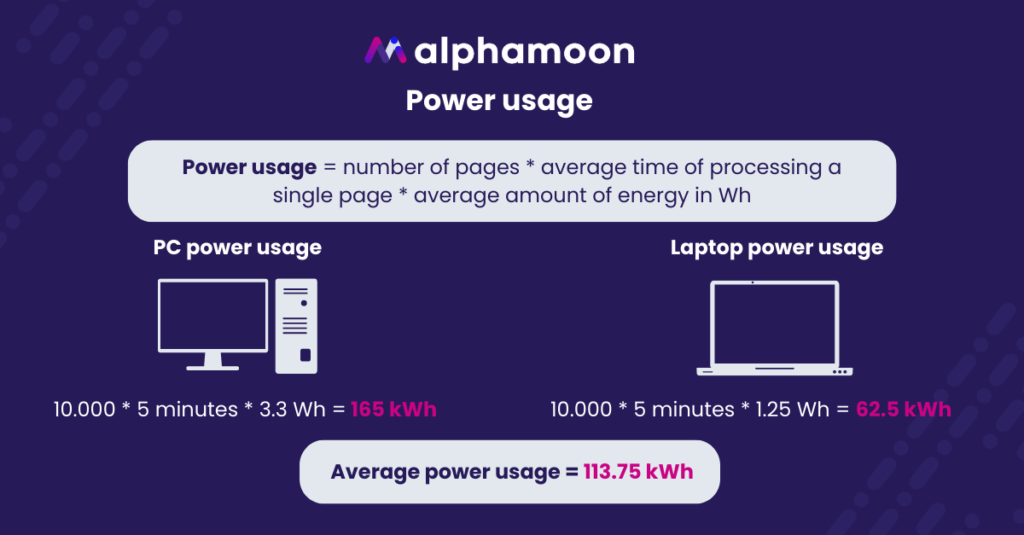Document automation aligns with sustainability-first values by reducing power consumption by 80% compared to manual work.
In this article, you’ll learn about:
- the shift in business strategy toward sustainability
- how document automation cuts power consumption by 80%
- how AI for documents supports a paperless office
- other areas where AI for documents supports green initiatives

Sustainability shapes the modern business world
Achieving a more sustainable business model encapsulates a variety of actions that a company can undertake to become more appealing to customers.
Days of jaw-dropping prices are over in the post-pandemic times when consumers feel the impact of an overloaded supply chain or poor online shopping experience. On top of that comes the uncertainty resulting from the geopolitical situation we’re facing in Europe. The Russian invasion of Ukraine has destroyed the peace in the old continent, wreaking havoc and disturbing all elements of socioeconomic balance. The consequences are nothing but dire – from war casualties to the long-term economic impact.
Such events as the global pandemic and war also impact the business world. Most importantly, price is no longer the most powerful leverage. Companies can lose customers due to longer shipping times faster than by increasing the product’s price. And they often don’t have any control over external factors that cast a shadow on their operations and growth opportunities.
Today’s shoppers – particularly Gen Z representatives – are far more concerned about the planet than the past generations. According to research, Gen Z is eager to pay 10% or more for sustainable products. By 2030, they will encompass over 27% of the global population, which has a straightforward answer to all brands that aren’t sure if being green is to be embraced.
Perhaps sustainability, a buzzword that has cemented itself in the DNA of every brand nowadays, will be the economy-shaping force in the next couple of years too. Although the concept has been circling back and forth for decades in the corporate corridors, the demand side had to grow more conscious about its meaning.
Nowadays, business leaders know that ESG initiatives (environment, society & governance) will only gain importance. McKinsey’s report reveals that 83% of C-level execs admit ESG initiatives will generate more shareholder value in the upcoming years.

In business-to-business operations, sustainability might seem less important on the surface. After all, the primary principle of neoclassical economics holds still – individuals maximize utility while firms maximize profits. Yet companies are held accountable for their entire conduct, not only the most convenient cut that stays in the spotlight for consumers to admire. Take Patagonia as the leading example of how the pledge to protect future generations is embedded in the brand’s DNA. The company has recently donated the entire operations to charity.
While many steps need to be taken on a macro-scale, companies like yours can act to lead sustainability-first strategies – even in business-to-business operations. One of the challenging areas to introduce greener innovations is paperwork and document circulation. As experts in intelligent document processing, the Alphamoon team has looked into ways document automation supports the sustainability mission. Take a look at the two case studies below.
Case Study #1 – How document automation reduces energy consumption
The implementation of Alphamoon’s IDP platform results in two main sustainability-related benefits:
- automation of the process that reduces the computing time required for processing one document
- moving document processing from PCs and laptops to cloud solutions
Let’s look at the numbers.
Our calculations establish the average power usage per user, differentiating between a PC, a laptop, and a cloud service. The amounts are expressed in watt-hours.
PC uses 3.3 Wh, a laptop 1.25 Wh, while cloud solution only 0.2 Wh per minute.
The average power usage per PC and laptop equals 2.27 Wh per minute.

To simplify the model, we established an average time for processing a single document page for humans and measured the same metric for Alphamoon’s platform.
Humans need 5 minutes compared to 0.16 minutes in the case of Alphamoon’s IDP solution.
To finalize the equation, we need the level of savings known as the automation level. Automation indicates the reduced time saved by implementing robotic processing into a workflow.
Note: Our Guide to IDP explained the ins and outs of intelligent document processing. It might come in handy to learn more about the technology described here.
The average level of automation may vary between use cases (examples of use cases: automated invoice processing, OCR for receipts, etc.). Since this metric varies between 70% and 90%, the power consumption estimation takes the median of 80%.
All pieces of the puzzle are ready for the final equation. The following formula was used to calculate the processing time and energy for 10.000 pages of documents by humans without the support of AI automation:
Power usage = number of pages * average time of processing a single page * average amount of energy in Wh
This translates to two equations:
Power use (PC) = 10.000 * 5 minutes * 3.3 Wh = 165 kWh
Power use (laptop) = 10.000 * 5 minutes * 1.25 Wh = 62.5 kWh
The average of these results equals 113.75 kWh.

A common misinterpretation of AI implementation is that it removes humans from the workflow, and that is not true. AI-based tools are human-centered, meaning they only facilitate processes and tasks; however, human supervision is necessary.
Note: We cover the topic of how automation includes human participation in the loop in our article about robots taking our jobs.
Since humans work with the document processing tool, we have included the time needed to work with the platform in the equation below. Since the automation level reaches 80%, the remaining 20% refers to human work.
Power use (AI) = 20% * 10.000 pages * 5 min * 2.27 Wh + 80% * 10.000 pages * 0.16 min * 0.2 Wh
After performing the above calculation, we end up with:
Power use (AI) = 22.7 kWh + 0.3 kWh = 23 kWh
The last step in the calculation is to bring the average power use without automation and compare it with the AI-supported platform.
Power use (SAVING) = (23 kWh / 113.75 kWh) * 100% ~ 80%

The level of automation is not dependent on the number of pages, so as a consequence of introducing AI for documents, a company can reduce energy consumption by ~ 80%.
The monetary value of 80% of energy reduction consumption
We can express the above saving in energy in monetary terms.
According to Eurostat, the average price of 1 kWh of energy for non-household consumers was €0.1445 (calculated for the 2nd half of 2021). Non-household consumers are defined by usage between 500 MWh and 2 000 MWh.
Fresh data concerning non-household consumers is not available, but the Russian invasion on Ukraine has caused surges in energy prices. The change for household consumers went up from €0.2369 (Statista) by ~69% on average.
You can see how we’ve arrived at this number below.

Based on the above estimations, we can assume that current price may be around €0.2441.
Let’s use this data to calculate the cost of manually processing 10.000 pages of documents vs. with the assistance of an IDP platform. We have established in the previous case study that the average energy consumption is 113.75 kWh for manual processing and 23 kWh for the IDP platform.
Cost (1) = €0.2441 * 113.75 kWh = €27.76
Cost (2) = €0.2441 * 23 kWh = $5.61
Considering the above, the cost reduction per 1 kWh equals $22.
As the number of pages to process grows, this decrease in spending becomes more significant.
Let’s study a case where the business processes 10.000.000 pages of documents.
The cost reduction would amount to $22.000 – a significant cut for any medium-sized business.

While surging energy prices can become quite a burden, there are other hidden costs related to paperwork in an office. In the next section – Case Study #2 – we explain the benefits of going paperless thanks to the implementation of AI for documents.
Case Study #2 – How document automation cuts costs of printing and paper usage
The second case study concerning document automation and sustainability going hand in hand is paper.
On average, an office worker prints 10.000 pages annually. The energy needed for the printer, paper, and other maintenance costs can be rounded up to €500 annually per employee (*10.000 sheets of paper cost around €200*). That may seem insignificant for small businesses, but €500 multiplied by 100 workers is €50.000.
When document circulation becomes digitized, that cost can be significantly reduced.
Research from PwC sheds more light on the hidden costs of paperwork in an office. According to the consulting company, employees spend 8 hours weekly on manual document management. Furthermore, a lost document costs roughly $120*; the average number of lost documents annually is 750.
That’s $90.000 saved annually on mistakes and mismanagement.

Note: This cost encapsulates time spent preparing new documents, working hours of employees engaged in the process, and so on.
Costs aside, going paperless means saving trees, right?
You may be tempted to fall for the recent trend of saving trees as the ultimate means of showing you care about the planet. When you dig deeper, the image of your company being the planet’s saviour isn’t quite accurate.
While there are companies – such as OneTreePlanted – that help promote responsible forestry and repopulate the most damaged parts of the world, such as Haiti – the truth is that cutting trees has not been the biggest reason for climate change. Forests are our green lungs, and they do limit the negative impact of human activity.

However, the true culprits are companies that pollute air and water on a massive industrial scale – 71% of global gas emissions were due to the operations of 100 companies (according to a report from 2017). Even the pandemic managed to reduce emissions only for a couple of months, and the CO2 emissions from energy combustion and industrial processes reached all-time high in 2021.

No reasonable amount of trees can handle that.
Take a look at what SierraClub’s Mr. Green had to say about the tree-cutting matter:
(…) we discover that this Platonic-yet-real yet-dead tree contains roughly 10 cubic feet of wood. So it would take about 8 of these trees to produce between 1,000 and 2,000 pounds of paper; since a typical 500-sheet packet of paper weighs 5 pounds, that’s 10,000 to 20,000 sheets per tree, which doesn’t sound all that bad. That’s why the most effective way to shock your colleagues is 1) to address the volume of paper unnecessarily used in the first place, and 2) note the vast amount that gets wasted instead of recycled.

Benefits of going paperless
So, is “paperless” just a buzzword, then?
Definitely not.
As we’ve mentioned, going paperless helps your company save money and can be used to push more sustainability-oriented initiatives. It’s about reducing the use of paper to an absolute minimum and ensuring that once it becomes waste – it is correctly disposed of.
Decreasing the paper’s circulation also reduces the risks of privacy breaches and data mismanagement and increases productivity. In the broader perspective, promoting upcycling waste and helping local governments lead environmental initiatives are just some ideas that any company can turn into action points. After all, a conscious business goes beyond its profit to consider its impact on society and the environment.
And, of course, paperless offices mean building a better future for generations that will be happy about every tree you’ve saved.

Conclusion
There you have it. The answers are pretty straightforward if you have ever wondered what the green impact of document automation could be. Your company can save on energy consumption and costs related to paper usage but also mitigate risks of unnecessary losses related to lost documents.
Sounds like a plan? Get in touch with our sales team.
Or carry on reading:



